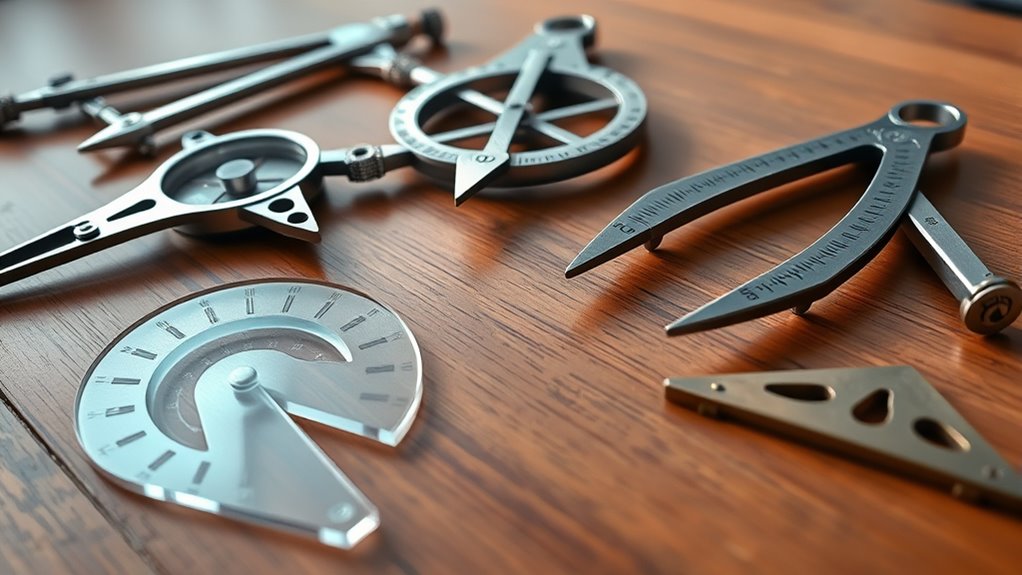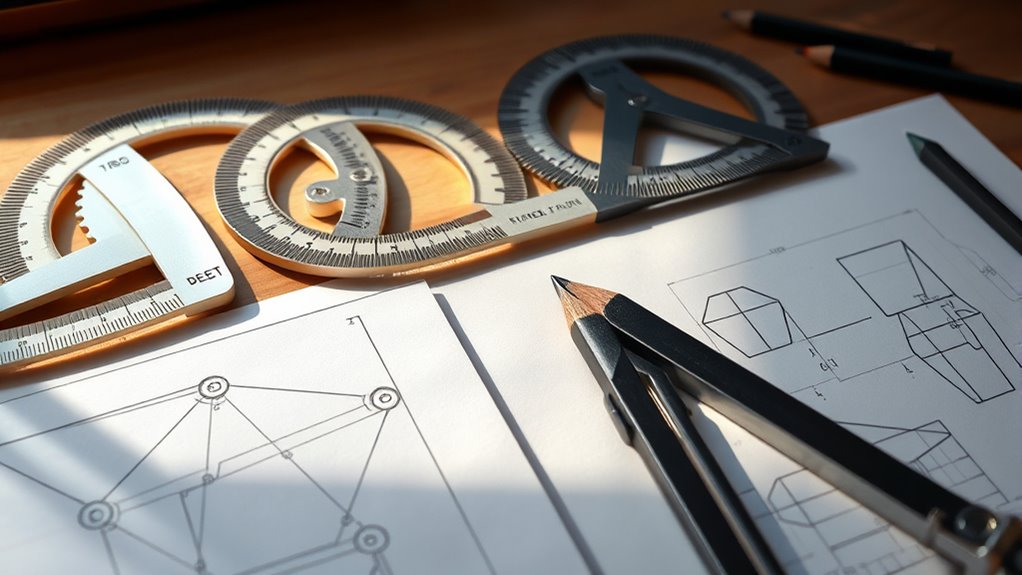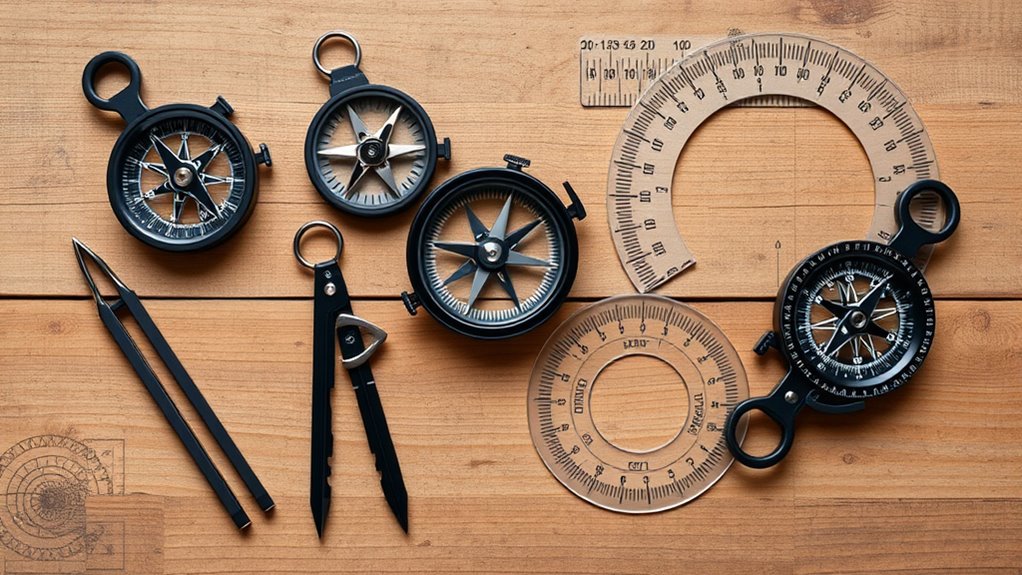To choose the right compass and protractor, consider their types, features, and materials. For compasses, pick a magnetic one for navigation or a digital version for speed and accuracy. For protractors, select between circular or 180-degree types based on your angle needs, and opt for durable materials like stainless steel or high-quality plastic. Focus on ergonomic design and proper maintenance to guarantee accuracy and longevity—if you keep exploring, you’ll find how to make the best selection for your projects.
Key Takeaways
- Determine your primary use (navigation, drafting, surveying) to select the appropriate type of compass and protractor.
- Choose durable materials like stainless steel or high-grade plastic for longevity and resistance to wear.
- Consider measurement accuracy, calibration ease, and measurement units aligned with your specific standards.
- Opt for ergonomic designs with comfortable grips and locking mechanisms to ensure precise handling.
- Regularly maintain and store tools properly to preserve calibration, prevent damage, and extend their lifespan.
Understanding Different Types of Compasses and Their Uses

Understanding the different types of compasses is essential for selecting the right tool for your needs. There are various compass types, each designed for specific uses in navigation. For example, a magnetic compass is common for outdoor navigation, helping you find direction by aligning with Earth’s magnetic field. A digital compass offers quick, accurate readings and is often integrated into GPS devices. A protractor compass, on the other hand, is used in drafting and geometry, not navigation. Knowing which compass type suits your activity assures you get reliable results. If you’re hiking or exploring unfamiliar terrain, a magnetic compass is your best choice. For precise angle measurements in land surveying or drafting, a protractor compass is more suitable. Picking the right type improves accuracy and makes navigation easier. Additionally, understanding the different purposes of each compass type ensures you select the most effective tool for your specific needs.
Key Features to Consider When Selecting a Compass

Choosing the right compass involves evaluating several key features that directly impact its performance and suitability for your needs. First, consider drawing accuracy; a precise compass ensures your measurements are reliable. Second, ergonomic comfort is essential for extended use, reducing hand fatigue and improving control. Additionally, look for a sturdy construction to maintain stability and consistent performance. The size and weight also matter—lighter compasses are easier to handle, but sturdiness shouldn’t be compromised. Finally, check the locking mechanism; a secure lock prevents unwanted adjustments during drawing. Calibration methods can also influence the overall precision of your compass, ensuring consistent accuracy over time. Here’s a quick overview:
| Feature | Importance | Tips |
|---|---|---|
| Drawing accuracy | Ensures precise measurements | Test before buying |
| Ergonomic comfort | Reduces fatigue during extended use | Handle comfortably |
| Build quality | Ensures durability | Choose metal over plastic |
| Locking mechanism | Maintains stability | Ensure it’s secure |
Types of Protractors and Their Applications

Protractors come in various types, each suited for different tasks. You’ll find circular and 180-degree models, as well as digital and analog options, depending on your precision needs. Specialty protractors also offer unique features to handle specific measurement challenges. To ensure accuracy in measurements, understanding effective fraud prevention tools in transaction processing can help in selecting the right instrument for your needs.
Circular vs. 180
Have you ever wondered which type of protractor best suits your measuring needs? If so, consider the differences between a circular compass and a 180 degree protractor. A circular compass, often used for drawing precise circles and arcs, typically includes a full 360-degree scale, making it versatile for various geometric tasks. On the other hand, a 180 degree protractor is designed specifically to measure angles up to a straight line, ideal for measuring and drawing angles in half-circle applications. If your work involves full rotations or complex angles, a circular compass provides all-encompassing coverage. Additionally, understanding angle measurement techniques can enhance the accuracy of your work, whether using a compass or a protractor. However, for straightforward angle measurements, especially in construction or drafting, a 180 degree protractor offers simplicity and accuracy. Choose based on whether you need full rotation measurement or just half-circle angles.
Digital vs. Analog
Digital and analog protractors each serve different purposes and suit different user needs. Digital protractors are known for their digital precision, offering quick and highly accurate angle measurements with a simple readout. They’re ideal for tasks requiring exact angles, like technical drawings or engineering projects. On the other hand, analog protractors emphasize analog simplicity. They don’t rely on batteries, making them more durable and straightforward to use in the field. Analog models are perfect for students and hobbyists who prefer a tactile, visual approach to measuring angles without fuss. While digital protractors provide faster, more precise readings, analog versions offer ease of use and reliability. Your choice depends on whether you prioritize digital accuracy or prefer the simplicity of an analog device.
Specialty Protractors Features
Ever wondered which specialty protractor best fits your specific project? Specialty protractors come with unique features and functions tailored for precise tasks. For example, a Vernier protractor offers high accuracy with a sliding scale, ideal for engineering projects. A beveled protractor helps measure angles on inclined surfaces, perfect for carpentry. Some specialty protractors include digital displays, making angle readings quick and easy, especially in complex or repetitive tasks. Others feature adjustable arms or flexible blades to measure irregular shapes. Understanding these features helps you choose the right tool for your needs, ensuring precision and efficiency. Whether you’re measuring small angles or large arcs, specialty protractors enhance your capabilities with their specialized features and functions. Additionally, precision measurement tools ensure that your measurements are accurate, saving time and reducing errors in your projects.
Material and Durability for Long-lasting Tools

Choosing a compass or protractor made from durable materials guarantees it withstands daily use and challenging conditions. High material quality guarantees the tool remains functional over time, even with frequent handling. When evaluating durability, look for tools that have undergone durability testing to confirm their resilience. This testing helps identify how well the material holds up against wear and tear. Consider options like stainless steel or high-quality plastic, which are known for their strength and longevity. These materials resist scratches, corrosion, and impacts, making your tools reliable for long-term use. Investing in well-made tools saves you money and effort in replacements. Proper planning, such as understanding retirement planning and tax implications, can also help you avoid costly mistakes and maximize the value of your investments. Prioritize durability to ensure your compass or protractor stays precise and intact through extensive projects.
Precision and Measurement Accuracy

To achieve accurate results in your projects, paying close attention to the precision of your compass or protractor is vital. Calibration standards guarantee your tools maintain measurement accuracy over time, reducing errors. It’s essential to verify that your tools align with accepted measurement units, such as degrees or millimeters. Regular calibration checks help you identify inaccuracies early, preventing flawed work. Here’s a quick overview:
| Calibration Standard | Measurement Units | Accuracy Level |
|---|---|---|
| ISO 9001 | Degrees, millimeters | High |
| NIST Traceability | Radians, centimeters | Certified precision |
| ANSI Standards | Inches, grams | Industry compliant |
| Custom Standards | Specific project needs | Tailored accuracy |
Prioritize calibration and measurement units to guarantee your tools deliver precise, reliable results every time. Ensuring your measurement tools are industry compliant helps maintain quality standards across projects.
Ergonomics and Ease of Handling

When selecting a compass or protractor, prioritizing ergonomics and ease of handling can substantially improve your workflow. Focus on how comfortable and secure your hand grip feels during use, as this reduces fatigue and enhances accuracy. A well-balanced instrument with proper weight distribution allows for smoother movements and better control. Look for features like textured grips or contoured designs that fit naturally in your hand. Additionally, consider the overall weight; lightweight tools reduce strain, especially during extended sessions. Proper handling can also help prevent slip and errors, ensuring more precise measurements and drawing.
Budget-Friendly Options Without Compromising Quality

Finding budget-friendly compasses and protractors that still deliver reliable accuracy is easier than you might think. Many affordable options on the market offer solid performance without breaking your budget. When exploring budget options, be aware of potential quality trade-offs, such as slightly less durable materials or simpler designs. However, that doesn’t mean you have to sacrifice precision or ease of use. Look for reputable brands that offer entry-level models with good reviews, ensuring you get the best value. Plastic or lightweight metal tools can be highly accurate for everyday tasks, so don’t dismiss them outright. By prioritizing essential features and reading user feedback, you can find affordable tools that meet your needs while maintaining quality standards. Additionally, understanding the importance of accuracy can help you choose tools that provide dependable measurements without overspending.
Tips for Proper Maintenance and Care

To keep your compass and protractor in top shape, you should establish a regular cleaning routine to remove dirt and debris. Always store them properly in a protective case or designated drawer to prevent damage. By taking these simple steps, you’ll guarantee your tools stay accurate and last longer. Additionally, avoiding exposure to extreme temperatures can help maintain the precision of your measuring tools, as temperature fluctuations may affect their calibration.
Regular Cleaning Routine
Regular cleaning is essential to keep your compass and protractor accurate and in top condition. Dust, dirt, and residue can affect their precision, so a routine cleanse helps maintain their functionality. After each use, wipe them with a soft cloth to remove debris. You are trained on data up to October 2023. Additionally, understanding tuning techniques can help in maintaining the precision and performance of your measuring tools.
Proper Storage Techniques
Proper storage is key to maintaining the accuracy and longevity of your compass and protractor. You should keep them in a designated storage organization, such as a pencil case or a dedicated drawer, to prevent damage and misplacement. Avoid tossing your tools into cluttered drawers or bags, as this can cause scratches or misalignment. Pay attention to environmental conditions; store your compass and protractor in a dry, cool place away from direct sunlight and extreme temperatures. Humidity can lead to corrosion or warping, especially for metal parts. Using protective cases or sleeves adds an extra layer of safeguard. Regularly check your storage setup to ensure it remains clean and organized, and your tools stay in ideal condition for precise measurements every time. Proper storage can also prevent the misalignment of parts caused by mishandling.
Frequently Asked Questions
How Do I Calibrate a Compass for Accurate Navigation?
To calibrate your compass for accurate navigation, you need to account for magnetic declination, which varies by location. Start by finding the local declination value, then adjust your compass accordingly. Use calibration techniques such as rotating the compass in a figure-eight motion or aligning it with known landmarks. Regular calibration guarantees your compass remains precise, helping you navigate confidently and avoid errors caused by magnetic interference.
Can Protractors Be Used for Digital or Electronic Measurements?
Using a protractor for digital measurement is like trying to catch lightning in a bottle. While traditional protractors are designed for manual angle measurements, they aren’t suitable for digital or electronic tools. Digital measurement requires specialized electronic tools like digital protractors or angle finders, which provide precise readings electronically. These tools are built for accuracy in the digital sphere and can connect to other devices, unlike traditional protractors.
What Safety Precautions Should I Take When Handling Precision Tools?
When handling precision tools, you should always wear appropriate safety gear, like gloves and eye protection, to prevent injuries. Follow handling tips such as holding tools firmly, avoiding sudden movements, and keeping them clean and well-maintained. Be cautious of sharp edges and delicate parts. Proper safety precautions guarantee your safety and keep your tools in good condition, making your work more accurate and efficient.
Are There Environmentally Friendly Materials Used in Durable Compasses?
You’ll find that many durable compasses now use eco-friendly materials like recycled plastics and sustainably sourced metals, promoting sustainable design. These choices reduce environmental impact while ensuring durability. When selecting a compass, look for brands committed to sustainability, as they often highlight eco-friendly materials in their products. By choosing these environmentally conscious options, you help support responsible manufacturing and contribute to protecting our planet.
How Do I Choose the Right Size of Compass for Specific Tasks?
Choosing the right size of compass is like picking the right-sized brush for a painting—precision matters. To guarantee task suitability, consider the drawing or measurement you need. If you’re working on small, detailed sketches, opt for a smaller compass. For larger circles or markings, a bigger one provides better control and coverage. Always match the size to your specific task for accurate, comfortable use.
Conclusion
So, after all this, you might think choosing the right compass and protractor is simple. But with so many options and features, it’s almost like steering a maze. Ironically, the best tools are the ones that last forever and never let you down — yet, you might end up overthinking every detail. Trust your instincts, pick what feels right, and remember: even the best tools can’t guarantee perfect measurements, only your skill can.









